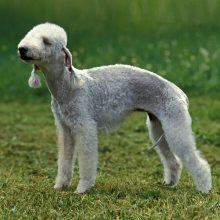Bedlington Terrier
Lifestyle Needs

The Bedlington Terrier is a unique looking breed – looking more like a lamb than a dog. He has a lamb-like head and tightly curled coat which needs regular grooming and fairly frequent trimming. He’s tougher than he looks and retains a sporty, terrier disposition. He makes a suitable family pet and will be happy to join in with most family activities. Regular exercise is very important.
Genetic Diversity
(Known as Coefficient of Inbreeding: 'COI'. It should be as low as possible.)
The UK Kennel Club breed average COI is 12.0% - See 'A Beginners Guide to COI'
Gene Pool Size
(Known as Effective Population Size: 'EPS')
48.3
EPS is a measure of how many individuals are contributing genetically to a breed population. It is a measure of the size of the gene pool in a breed. Lower than 100 is considered critical by conservationists and below 50 brings a breed close to extinction. For more information see the Kennel Club article.
Health and Welfare Problems due to Conformation
(Body shape and physical characteristics)
- The Bedlington’s coat will harbour dirt and debris, causing possible skin problems, unless regularly groomed and trimmed.
BVA/KC Health Schemes: www.bva.co.uk/chs
- Eye disease: Total retinal dysplasia (TRD) (litter screening)
Estimated Breeding Values (EBVs) : No EBVs are currently available for this breed
www.thekennelclub.org.uk/about-ebvs
DNA Tests Available
DogWellNet and IPFD Harmonisation of Genetic Testing for Dogs (HGTD)
www.dogwellnet.com/breeds
- Copper Toxicosis (COMMD1-CT Type) High incidence in this breed 33%
- Copper Toxicosis (ATP7B Type)
- Primary lens luxation (PLL)
- Hereditary Footpad Hyperkeratosis (HFH)
Availability of a DNA test does not mean that it is always necessary or even desirable for breeders to use this test.
Other Breed-Specific Health Screening Schemes
None known
Breed health website: www.bedlingtonterrierhealthgroup.org.uk
Ask the breeder to show you the certificates for the above tests/screening for both parents. If any of the above tests have not been considered necessary by the breeder (and there may be good reasons), ask her to explain why.
Other Diseases Reported
(For which there are currently no genetic or screening tests for sire or dam)
- Chronic hepatitis (due to copper storage problems)
- Cataract
- Congenital keratoconjunctivitis sicca
- Distichiasis
- Entropion
- Lacrimal punctal atresia
Ask the breeder about the medical history of the parents, grandparents and great grandparents. Consider carefully whether to purchase a puppy if some of these or other diseases are in the family line.
Ask about the breeder’s policy in cases of serious genetic diseases occurring to your puppy in later life. Good breeders will request to be informed of such events in order to improve future breeding decisions.
You are strongly advised to buy from a breeder who uses (or is prepared to use) the AWF Puppy Contract and Puppy Information Pack (PIP): www.puppycontract.org.uk
The breeder should also be familiar with the CFSG/DBRG Code of Practice for Dog Breeding
Or the Kennel Club’s Assured Breeders Scheme Standard and Guidance:
Standard PDF | Guidance PDF